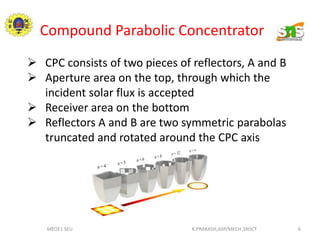1.CPC.pptx
- 1. SOLAR ENERGY UTILISATION Compound Parabolic Collector 1 16MEOE1 SEU K.PRAKASH,ASP/MECH,SNSCT
- 2. Solar collectors clasification 2 16MEOE1 SEU K.PRAKASH,ASP/MECH,SNSCT
- 3. Concentrating Collectors 3 16MEOE1 SEU K.PRAKASH,ASP/MECH,SNSCT âĒ A solar collector that uses reflective surfaces to concentrate sunlight onto a small area âĒ Concentrators can increase the power flux of sunlight hundreds of times âĒ Concentrating PV modules/arrays track the sun and use concentrating devices to reflect direct sunlight âĒ Collectors use both diffuse and beam solar radiation and do not require tracking of the sun
- 4. Need for Compound Parabolic Concentrator 4 16MEOE1 SEU K.PRAKASH,ASP/MECH,SNSCT ï System operated at temperature below 100 šC due to limited solar energy intensity on the solar panel ï solar incident on a large area to a small enough area to increase solar energy intensity ï parabolic trough concentrators, parabolic dish concentrators, lens concentrators, central tower concentrators, Fresnel concentrators ï All the concentrators require accurate tracking systems ï Compound parabolic concentrators (CPCs) collects solar energy without tracking systems.
- 5. Compound Parabolic Concentrator 5 16MEOE1 SEU K.PRAKASH,ASP/MECH,SNSCT ï Compound Parabolic Concentrator comprised of two parabolic mirror segments with different focal points ï The two parabolic surfaces are symmetrical with respect to reflection through the axis of the CPC ï Relative high temperature operations with high cost effectiveness.
- 6. Compound Parabolic Concentrator 6 MEOE1 SEU K.PRAKASH,ASP/MECH,SNSCT ï CPC consists of two pieces of reflectors, A and B ï Aperture area on the top, through which the incident solar flux is accepted ï Receiver area on the bottom ï Reflectors A and B are two symmetric parabolas truncated and rotated around the CPC axis
- 7. Compound Parabolic Concentrator 7 16MEOE1 SEU K.PRAKASH,ASP/MECH,SNSCT






